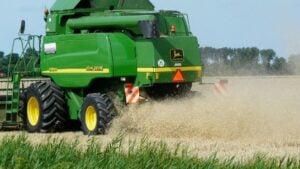
When autumn comes to Michigan, a common sight on rural roads are large but slow-moving farm vehicles that are coming from or going to a field for harvest. These farm vehicles are a great source of frustration for other Michigan motorists who find they are difficult to pass due to their immense size. A driver who takes risky and evasive action to get around farm implements can increase the chances of being involved in a collision. There are rules that apply to farm equipment on open roads not applicable to other motor vehicles that all drivers should be aware of.
RULES FOR OPERATING FARM VEHICLES ON PUBLIC ROADWAYS UNDER THE MICHIGAN VEHICLE CODE AND FEDERAL LAW
The Michigan Vehicle Code uses the nomenclature “implements of husbandry” to refer to these types of farm vehicles. According to statute, “implement of husbandry” means “a vehicle or trailer in use for the exclusive function of serving agricultural, horticultural, or livestock operations. Implement of husbandry includes a farm tractor, self-propelled application-type vehicle, farm wagon, farm trailer, a vehicle or trailer adapted for lifting or carrying another implement of husbandry being used in agricultural production, or any substantially similar equipment used to transport products necessary for agricultural production.” MCL 257.21.
- A person, while driving a “a farm tractor or implement of husbandry temporarily drawn, moved, or propelled on a highway” is NOT required to have or possess an operator’s license to do so “if the person is a citizen of the United States or is otherwise eligible to be issued an operator’s license or chauffeur’s license”. MCL 257.302(b).
- An implement of husbandry is not subject to the registration and certificate of title provisions under the Michigan Vehicle Code. MCL 257.216(1)(c).
- An implement of husbandry is not subject to the 96-inch width limitation for vehicles and loads on Michigan highways. “A person may operate or move an implement of husbandry of any width on a highway as required, designed, and intended for farming operations, including the movement of implements of husbandry being driven or towed and not hauled on a trailer, without obtaining a special permit for an excessively wide vehicle or load…” MCL 257.717(2). However, “[t]he operation or movement of the implement of husbandry shall be in a manner so as to minimize the interruption of traffic flow. A person shall not operate or move an implement of husbandry to the left of the center of the roadway from a half hour after sunset to a half hour before sunrise…, or at any time visibility is substantially diminished due to weather conditions. A person operating or moving an implement of husbandry shall follow all traffic regulations.”
In 2012, President Barack Obama signed legal provisions into law known as the Moving Ahead for Progress in the 21st Century (MAP 21) Act. Beginning October 1, 2015, new federal highway provisions became enforceable in Michigan by local law enforcement but provided a number of exceptions from federal regulations regarding “covered farm vehicles”.
As defined in 49 CFR § 390.5, “covered farm vehicle” means a straight truck or articulated vehicle with ALL of the following–
- “Registered in a State with a license plate or other designation issued by the State of registration that allows law enforcement officials to identify it as a farm vehicle”;
- “Operated by the owner or operator of a farm or ranch, or an employee or family member of an owner or operator of a farm or ranch”;
- “Used to transport agricultural commodities, livestock, machinery or supplies to or from a farm or ranch”; and
- “Not used in for-hire motor carrier operations” UNLESS operating “by a tenant pursuant to a crop share farm lease agreement to transport the landlord’s portion of the crops under that agreement.”
- And EITHER of the following:
-
- “With a gross vehicle weight rating or gross combination weight rating, or gross vehicle weight or gross combination weight, whichever is greater, of 26,001 pounds or less” operated anywhere in the United States; OR
- “With a gross vehicle weight rating or gross combination weight rating, or gross vehicle weight or gross combination weight, whichever is greater, of more than 26,001 pounds” if operated anywhere in the State of registration or across State lines within 150 air miles of the farm or ranch with respect to which the vehicle is being operated.
Under federal law, a Commercial Driver’s License (CDL) is not required anymore for operators of “covered farm vehicles” with a gross vehicle weight rating (GVWR) gross combination weight rating (GCWR), gross vehicle weight (GVW) or gross combination vehicle weight (GCVW) of 26,001 pounds or less in all of Michigan or in interstate transportation. 49 CFR § 390.39(a)(1). For “covered farm vehicles” greater than 26,001 GVWR, GCWR, GVW or GCVW, you will not need a CDL when operating in Michigan or across state lines within 150 miles of the farm or ranch provided the vehicle has a Michigan registration. Id. However, if the farm vehicle is hauling a hazardous material in a quantity requiring placarding, such as anhydrous ammonia, the driver needs both the CDL and an H or X (hazardous) endorsement. 49 CFR § 390.39(b)(2).
Other exemptions from federal regulations for “covered farm vehicles” include:
- “Any requirement relating to controlled substances and alcohol use and testing in 49 CFR Part 382.” 49 CFR § 390.39(a)(1).
- “Any requirement in 49 CFR Part 391, Subpart E, Physical Qualifications and Examinations.” 49 CFR § 390.39(a)(2).
- “Any requirement in 49 CFR Part 395, Hours of Service of Drivers.” 49 CFR § 390.39(a)(3).
- “Any requirement in 49 CFR Part 396, Inspection, Repair, and Maintenance.” 49 CFR § 390.39(a)(4).
However, “covered farm vehicles” and drivers must comply with federal regulations and state laws regarding:
- Federal Motor Carrier Safety Regulations; General (49 CFR Part 390)
- Driving of Commercial Motor Vehicles (49 CFR Part 392)
- Parts and Accessories Necessary for Safe Operation (49 CFR Part 393)
- All state motor vehicle size and weight, safety and operation laws.
Drivers of covered farm vehicles must operate on the open roads with all of the care and responsibilities that a CDL driver in a commercial vehicle would unless specifically exempted by statute or regulation.
NECESSARY EQUIPMENT ON FARM VEHICLES OPERATED IN MICHIGAN
Due to the slow-moving nature of farm vehicles on the road, Michigan law requires the following equipment to be installed before entry on the road:
- “[W]hen operated on the highway, every vehicle that has a maximum potential speed of 25 miles an hour, implement of husbandry, farm tractor, modified agriculture vehicle, or special mobile equipment shall be identified with a reflective device as follows:”
-
- “An equilateral triangle in shape, at least 16 inches wide at the base and at least 14 inches in height: with a dark red border, at least 1-3/4 inches wide of highly reflective beaded material.” MCL 257.688(1)(g)(i).
- “A center triangle, at least 12-1/4 inches on each side of yellow-orange fluorescent material.” MCL 257.688(1)(g)(ii).
- “[This triangle] shall be mounted on the rear of the vehicle, broad base down, not less than 3 feet nor more than 5 feet above the ground and as near the center of the vehicle as possible. The use of this reflective device is restricted to use on slow moving vehicles specified…, and use of such reflective device on any other type of vehicle or stationary object on the highway is prohibited. On the rear, at each side, red reflectors or reflectorized material visible from all distances within 500 to 50 feet to the rear when directly in front of lawful upper beams of headlamps.” MCL 257.688(2).
- For implements of husbandry manufactured before January 1, 2007 and operated or moved on the highway, EITHER is required for rear lamps:
-
- “At least 1 rear lamp mounted on the rear which, when lighted, shall emit a red light plainly visible from a distance of 500 feet…”. MCL 257.686(4)(a)(i).
- “Be accompanied by a vehicle which follows behind the implement of husbandry at a distance of not more than 50 feet, illuminates the implement of husbandry with the vehicle’s headlights, and displays on the rear of the vehicle lighted rear lamps as required by [law]”. MCL 257.686(4)(a)(ii).
- For implements of husbandry manufactured on or after January 1, 2007 and operated or moved on the highway, the ANSI/ASAE S276.6 JAN2005, Slow-Moving Vehicle Identification Emblem AND the ANSI/ASAE S279.12 DEC02, Lighting and Marking of Agricultural Equipment on Highways is required to be affixed to the vehicle. MCL 257.686(4)(b).
A person shall not drive or move or the owner shall not cause or knowingly permit to be driven or moved on a highway a vehicle or combination of vehicles that is in such an unsafe condition as to endanger a person. MCL 257.683(1). A police officer may stop a motor vehicle and inspect it on reasonable grounds shown (e.g. cracked windshield, loud exhaust, broken light) and, if a defect in equipment is found, the officer may issue the driver a citation. MCL 257.683(2). Defective equipment violations are civil infractions punishable by a fine, but are considered non-moving violations that carry no points or license sanctions.
PENALTIES FOR MOVING VIOLATIONS THAT INJURE OR KILL FARM VEHICLE WORKERS
Other drivers must use due diligence and care when operating a motor vehicle around “implements of husbandry” on the open road or else risk enhanced criminal penalties:
- “A person who commits a moving violation that has criminal penalties and as a result causes injury to a person operating an implement of husbandry on a highway in compliance with this act is guilty of a misdemeanor punishable by imprisonment for not more than 1 year or a fine of not more than $1,000.00, or both.” MCL 257.601c(1). Six points will be added to the offender’s driving record. In addition, a first-time offender will have their operator’s license suspended for 90 days, but a second offense occurring within 7 years of the first offense will result in the Michigan Secretary of State revoking the operator’s license from 1 to 5 years with no hardship appeal.
- “A person who commits a moving violation that has criminal penalties and as a result causes death to a person operating an implement of husbandry on a highway in compliance with this act is guilty of a felony punishable by imprisonment for not more than 15 years or a fine of not more than $7,500.00, or both.” MCL 257.601c(2). Six points will be added to the offender’s driving record. In addition, the offender’s license will be revoked for at least 1 to 5 years with no hardship appeal.
- A “moving violation” means an act or omission prohibited under this act or a local ordinance substantially corresponding to the Michigan Vehicle Code that occurs while a person is operating a motor vehicle, and for which the person is subject to a fine. MCL 257.601c(3).
IF YOU ARE ACCUSED OF VIOLATING ANY TRAFFIC LAW, OUR LAW FIRM CAN HELP
A person accused of a civil infraction is not required to admit responsibility and can request a formal or informal hearing before a district court judge or magistrate. However, a misdemeanor or felony charge will require the driver to appear in district court to be formally arraigned on criminal charges. In either case, the defendant has the right to hire a criminal defense lawyer to defend against these traffic offenses. An experience traffic attorney at your side will hold the prosecutor to the burden of proving your guilt beyond a reasonable doubt. Even if the evidence against you is strong, the attorney may even be able to negotiate a resolution with the prosecutor that may involve admitting responsibility or pleading guilty to a reduced offense that carries no incarceration or license sanctions. Always consider speaking to a lawyer first to understand all the possible consequences facing you before making any decisions.
If you are charged with any traffic offense and need legal representation, then do not hesitate to contact the experienced attorneys at Kershaw, Vititoe & Jedinak PLC for assistance today.





